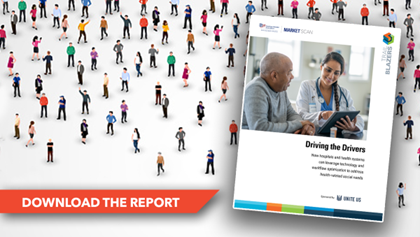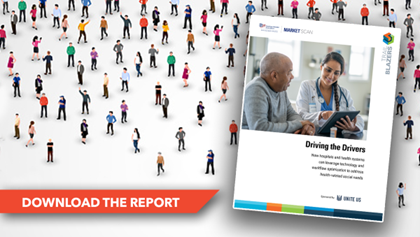

How to Unleash the Power of Health-Related Social Needs Data

Capturing health-related social needs (HRSN) data effectively and efficiently helps provider organizations leverage these data to meet the Quadruple Aim objectives: enhancing the patient experience, improving population health, reducing costs and improving the work life of health care providers.
Connecting patients with the resources they need to experience better health outcomes is a vital part of the HRSN screening process. With the right technology and resources, hospitals and health systems can identify inefficiencies and close gaps that could challenge the successful conclusion of that journey.
A new AHA Market Scan Trailblazers report, “Driving the Drivers,” explores how providers can leverage technology and workflow optimization to improve HRSN screening and connect patients with resources to address their health-related social needs.
Personalize Care Connections
Deploying enterprise technology that scales across the entire health system can connect patients with the right social network programs and resources and aid in tracking low-risk, rising-risk and high-risk populations. Key benefits of this approach include:
- Send and track closed-loop referrals from start to finish to see whether patients obtained services.
- Share personalized resource lists with patients, giving them easy access to the support they need.
- Find and share tailored resources that meet each patient’s unique care needs.
By integrating HRSN data into electronic health records (EHRs), providers can identify patterns and trends at scale across communities that may not be immediately evident when considering individual medical data alone.
Overall, EHR and HRSN data integration support a holistic approach to health care. This empowers organizations across the care continuum to address population health challenges at a systemic level. By recognizing and responding to HRSN efficiently, proactively and at scale, providers can reduce health care costs and better manage population health outcomes.
Standardize HRSN Data Management
New Mexico-based Presbyterian Healthcare Services (PHS) has standardized its approach to automating HRSN screening, reaping multifold benefits in the process.
Toni Grinstead, health equity consultant and senior program manager for community health, oversees Presbyterian’s initiatives to address social drivers of health, including an automated health-related social needs screening workflow. Leigh Caswell, vice president for community and health equity, oversees the network’s community health worker team and its social needs screening and referral work.
Before automating the HRSN screening process, Grinstead and Caswell describe the health system’s approach as “scattershot.”
Some of PHS’ clinic sites still used paper, rather than their EHR tool, to screen patients. That created a twofold data entry problem. Clinicians or support staff sometimes would enter data inaccurately into the EHR system or not at all if paper screens went missing. Other challenges included the lack of standardized workflows to screen all patients across all settings and the lack of integrated screening results into the EHR system and each patient’s EHR.
Harness the Power of HRSN Data
With PHS conducting more than 1.5 million HRSN screenings annually across nine hospitals, 40 primary or specialty clinics and five urgent care centers, effectively managing these data became critically important.
In early 2024, PHS migrated to an automated approach to managing HRSN screening data. Three systems — HRSN screening, EHR and portal — now work in concert to power the HRSN screening process as part of routine health care. This approach eliminated paper screenings, standardized screening workflows across care sites and integrated patients’ HRSN screening data into their EHRs and patient portals.
“Having technology support our [HRSN] efforts is really powerful. We know a lot more about what our communities need. We know a lot more about what resources exist in our communities. Now we can use those data to influence policy and investment at the state level and at the local level,” Caswell says.
Patients now can answer HRSN screening questions through the patient portal before scheduled visits, eliminating that responsibility from busy clinicians and clinical support staff. Screening workflows now are standard across all sites of care.
PHS asks 12 questions in eight HRSN domains: housing, food, transportation, utilities, interpersonal violence, alcohol use, substance use and tobacco use. Screening results now appear directly in patients’ records, enabling the care team to determine if patients are experiencing a social need. If so, the system automatically generates a list of recommended resources in patients’ after-visit summaries directly within the EHR.
“Because everything is interoperable, the technology allows us to screen patients every six months, and every person who interacts with that patient has access to those data,” Grinstead says. “Patients [and caregivers] don’t have to answer the same questions over and over again during an episode of care. That improves the patient experience and the caregiver experience.”
Download the full Trailblazers report to learn more about the power of automating the HRSN screening and data management process and explore how Yale New Haven Health has improved its workflow efficiency.



